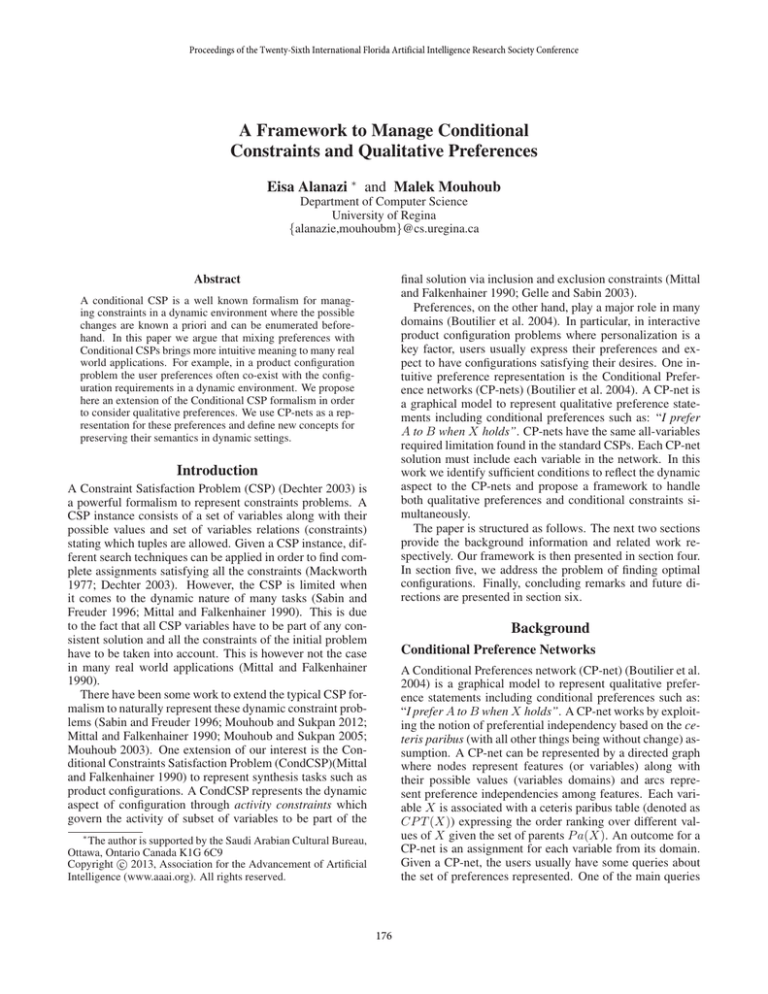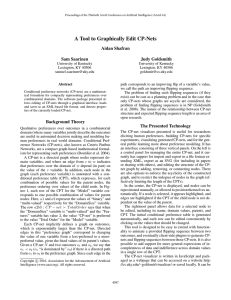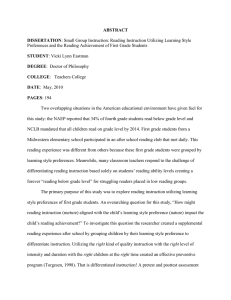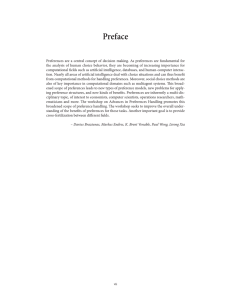
Proceedings of the Twenty-Sixth International Florida Artificial Intelligence Research Society Conference
A Framework to Manage Conditional
Constraints and Qualitative Preferences
Eisa Alanazi ∗ and Malek Mouhoub
Department of Computer Science
University of Regina
{alanazie,mouhoubm}@cs.uregina.ca
Abstract
final solution via inclusion and exclusion constraints (Mittal
and Falkenhainer 1990; Gelle and Sabin 2003).
Preferences, on the other hand, play a major role in many
domains (Boutilier et al. 2004). In particular, in interactive
product configuration problems where personalization is a
key factor, users usually express their preferences and expect to have configurations satisfying their desires. One intuitive preference representation is the Conditional Preference networks (CP-nets) (Boutilier et al. 2004). A CP-net is
a graphical model to represent qualitative preference statements including conditional preferences such as: “I prefer
A to B when X holds”. CP-nets have the same all-variables
required limitation found in the standard CSPs. Each CP-net
solution must include each variable in the network. In this
work we identify sufficient conditions to reflect the dynamic
aspect to the CP-nets and propose a framework to handle
both qualitative preferences and conditional constraints simultaneously.
The paper is structured as follows. The next two sections
provide the background information and related work respectively. Our framework is then presented in section four.
In section five, we address the problem of finding optimal
configurations. Finally, concluding remarks and future directions are presented in section six.
A conditional CSP is a well known formalism for managing constraints in a dynamic environment where the possible
changes are known a priori and can be enumerated beforehand. In this paper we argue that mixing preferences with
Conditional CSPs brings more intuitive meaning to many real
world applications. For example, in a product configuration
problem the user preferences often co-exist with the configuration requirements in a dynamic environment. We propose
here an extension of the Conditional CSP formalism in order
to consider qualitative preferences. We use CP-nets as a representation for these preferences and define new concepts for
preserving their semantics in dynamic settings.
Introduction
A Constraint Satisfaction Problem (CSP) (Dechter 2003) is
a powerful formalism to represent constraints problems. A
CSP instance consists of a set of variables along with their
possible values and set of variables relations (constraints)
stating which tuples are allowed. Given a CSP instance, different search techniques can be applied in order to find complete assignments satisfying all the constraints (Mackworth
1977; Dechter 2003). However, the CSP is limited when
it comes to the dynamic nature of many tasks (Sabin and
Freuder 1996; Mittal and Falkenhainer 1990). This is due
to the fact that all CSP variables have to be part of any consistent solution and all the constraints of the initial problem
have to be taken into account. This is however not the case
in many real world applications (Mittal and Falkenhainer
1990).
There have been some work to extend the typical CSP formalism to naturally represent these dynamic constraint problems (Sabin and Freuder 1996; Mouhoub and Sukpan 2012;
Mittal and Falkenhainer 1990; Mouhoub and Sukpan 2005;
Mouhoub 2003). One extension of our interest is the Conditional Constraints Satisfaction Problem (CondCSP)(Mittal
and Falkenhainer 1990) to represent synthesis tasks such as
product configurations. A CondCSP represents the dynamic
aspect of configuration through activity constraints which
govern the activity of subset of variables to be part of the
Background
Conditional Preference Networks
A Conditional Preferences network (CP-net) (Boutilier et al.
2004) is a graphical model to represent qualitative preference statements including conditional preferences such as:
“I prefer A to B when X holds”. A CP-net works by exploiting the notion of preferential independency based on the ceteris paribus (with all other things being without change) assumption. A CP-net can be represented by a directed graph
where nodes represent features (or variables) along with
their possible values (variables domains) and arcs represent preference independencies among features. Each variable X is associated with a ceteris paribus table (denoted as
CP T (X)) expressing the order ranking over different values of X given the set of parents P a(X). An outcome for a
CP-net is an assignment for each variable from its domain.
Given a CP-net, the users usually have some queries about
the set of preferences represented. One of the main queries
∗
The author is supported by the Saudi Arabian Cultural Bureau,
Ottawa, Ontario Canada K1G 6C9
c 2013, Association for the Advancement of Artificial
Copyright Intelligence (www.aaai.org). All rights reserved.
176
All the previous work except (Mouhoub and Sukpan
2008) and (Mouhoub and Sukpan 2012) have neglected the
notion of preferences when looking for CondCSPs solutions.
In (Mouhoub and Sukpan 2012) a Conditional and Composite CSP (CCCSP) framework has been extended to handle
four types of quantitative preferences. Similarly, preferences
in the context of temporal constraints have been proposed in
(Mouhoub and Sukpan 2008). However, to our best knowledge, the co-existence of qualitative preferences and CondCSPs have not been discussed in the literature.
is to find the best outcome given the set of preferences. Another important query is to check whether one outcome is
better than another. We say outcome oi is better than outcome oj if there is a sequence of worsening flips going from
oi to oj (Boutilier et al. 2004). A Worsening flip is a change
in the variable value to a less preferred value according to
the variable’s CPT.
Conditional Constraint Satisfaction Problems
A Conditional Constraint Satisfaction Problem (CondCSP)
(Mittal and Falkenhainer 1990) is a formalism to handle constraint problems where a set of variables can be added during
the search space. Unlike typical CSPs, CondCSPs have a set
of optional variables that can participate in the final solution
if they satisfy a particular type of constraints called activity
constraints. Therefore, each variable in a CondCSP is associated with an activation status (i.e. active or not active).
The set of activity constraints governs the participation of
optional variables in the solutions.
More formally, a CondCSP is represented as a tuple <
V, VI , D, CC , CA > where V is the set of all variables, VI
is the set of initial variables (i.e. variables that are initially
active), D is the set of possible values for each variable (its
domain) and CC and CA represent the set of compatibility
and activity constraints respectively. A compatibility constraint is typically a hard constraint in CSPs (Gelle and Sabin
2003). Activity constraints have an inclusion or exclusion
conditions in the form of A → B where A is a variable and
B is an optional variable (belonging to V − VI ) to include
or exclude and A can optionally have a value. An inclusion
incl
constraint A = a −−→ B means that B will be activated
(i.e. included) iff a is assigned to A. Similarly, the excluexcl
sion constraint has the form A = a −−→ B where the value
a is optional and B is excluded from the search space whenever the condition becomes true.
Extending CondCSPs with Preferences
Framework Definition
In this section we define our Preference Conditional Constraints Satisfaction Problem (PCCSP) model which extends
the CondCSP with the CP-net as follows. A PCCSP is a tuple < V, VI , CC , CA , N > where:
- V = {v1 , ...vn } is the set of all variables, each defined on
a domain Dvi of discrete values.
- VI is the set of initial variables. VI ⊆ V
- CC is the set of compatibility constraints.
- CA is the set of activity constraints.
- N is the set of preference variables. N ⊆ V and each
vi ∈ N has a CPT(vi ).
It has been shown that the exclusion constraints can always
be mapped to compatibility constraints (Gelle and Sabin
2003). Therefore, we consider only inclusion constraints in
this work.
Handling Preferences in a PCCSP
When considering the PCCSP, the following main questions
arise. First, how to check the consistency of the preference
statements in N ? In other words, how to identify the set
of feasible statements according to the problem constraints
(CC ) in the framework? Second, how should N behave towards the dynamic aspect of the PCCSP?. It is known that
the CP-net is a fixed preferences representation in a sense
that it is not possible to add new variables during the searching process.
For the first issue, we can adopt local consistency techniques (Mackworth 1977) to prune some inconsistent statements as described in (Alanazi and Mouhoub 2012). In the
latter, Arc Consistency is applied to prune some preference
statements and produce what so called Arc Consistent CPnets. The dynamic aspect of CondCSPs requires a closer attention in order to use CP-net as qualitative preference representation in our PCCSP framework. For instance, assume N
has been consulted for determining the most preferred value
to variable vi ∈ N . It is possible that one of the vi parents is
not active (i.e. no instantiation). How the CP-net is supposed
to behave in this case? For this issue we define a new concept called relevance for CP-nets. When solving the PCCSP
only active variables are considered. This requires revising
the CP-net N semantics to reflect the dynamic settings of the
framework. Therefore, we adopt the relevant notion to the
variables in N in order to tell whether the CP T (X) should
be consulted or not for a variable X ∈ N . In order to be
successful in using the CP T (X), we need to maintain the
Related Work
Different methods have been proposed in the literature to
solve CondCSPs (Mittal and Falkenhainer 1990; Gelle 2003;
Gelle and Sabin 2003; Sabin, Freuder, and Wallace 2003).
They differ by either solving CondCSPs directly or formulating the CondCSPs to standard CSPs. In (Mittal and
Falkenhainer 1990) CondCSPs have been presented for the
first time under the name of Dynamic CSPs. The authors
based their discussion on the configuration problems and
how it can be represented as CondCSPs. They proposed
a backtracking algorithm for directly solving CondCSPs.
They also discussed how to formulate the CondCSPs to standard CSPs by introducing special null values. (Gelle 2003)
introduced an algorithm to formulate CondCSPs to standard
CSPs for the problems containing discrete and continuous
variables. The authors discussed how to prune the search
space by adapting local consistency techniques. (Sabin,
Freuder, and Wallace 2003) provides more general nullbased formulation for CondCSPs problems. They also proposed new algorithms to maintain arc consistency and forward checking techniques in CondCSPs.
177
conditional independencies information. In other words, the
set of parents for X (P a(X)) must be active as well.
Definition 1 (Relevant Variable). A variable vi ∈ N is
relevant to the PCCSP iff vi is active and for every pi ∈
P a(vi ) the activity of pi holds.
In order to have complete specifications for different preference statements, we need to maintain not only the variables but also their dependencies (i.e. parents). Following
the definition of CP-nets, this results in a valid CP-net instance. Therefore, we generalize the relevance notion and
define it to the level of CP-nets.
Definition 2 (Relevant CP-net). A CP-net CP is relevant
to a given PCCSP iff each variable in CP is relevant.
Given a CP-net N associated with a PCCSP P , we can
classify N existence into two cases: (i) N exists only over
initial variables (i.e. N ⊆ VI ).(ii) N exists, possibly partially, over non initial variables (i.e. N ∩ (V − VI ) 6= ∅).
The former case is a trivial one and can be solved by typical
preference constrained optimization methods. Therefore, in
the following we consider only the case where preference
information exist over non initial variables.
ab : c c̄
ab̄ : c̄ c
āb : c c̄
āb̄ : c̄ c
a ā
A
C
b b̄
B
(a) The network
āb̄c
ab̄c
ab̄c̄
ābc
āb̄c̄
ābc̄
abc̄
abc
(b) The graph
Figure 1: Preference networks and its induced graph
to express this interest is through the specificity level. As
a result, a new concept is defined for dominance testing
which is a combination of both the specificity level and the
longest chain concepts named relative closeness (rc). The
relative closeness for an outcome o with regard to another
outcome d (denoted as rc(o, d) or rc(o) if d is obvious) is
equal to the following: rc(o, d) = lc(o) + (sl(d) − sl(o)).
As a result, we say oi dominates oj if the longest chain
of oi in addition to the difference in oi specificity level is
less than its analogue in oj . That is N |= oi rc oj iff
lc(oi ) + (sl(opt) − sl(oi )) < lc(oj ) + (sl(opt) − sl(oj )).
Existence over non-initial variables
In this case, a set of conditions must be defined in order to
reason about the CP-net N correctly. For instance, assume
Y ⊆ N is a valid CP-net and has been consulted to determine the most preferred value for a variable vi ∈ Y . It
is possible that one of the vi parents is not active (i.e. not
instantiated). The definition of relevant CP-net guarantees
that Y will be consulted only if all parents of vi are active.
Due to the dynamic behavior of the PCCSP, different solutions will have different arities. However, in CP-nets, the set
of outcomes always have the same arity since, at any time,
outcomes are defined over the same space. In our framework, preference outcomes are defined based on the relevant CP-net notion. Thus, we have different outcomes with
different arities. In the following we define the specificity
level (i.e. number of variables). Given two assignments
a1 = (x1 , ..., xn ) and a2 = (y1 , ..., ym ) we say a1 has specificity level n and a2 has specificity level m where m, n > 0.
Also, we say a1 is more specific than a2 iff n > m.
Definition 3. (Specificity level) Given an assignment ai for
PCCSP, we say ai is specific at level k (denoted as sl(ai ) =
k) iff the relevant CP-net associated with ai has k variables
(k = |Ni |).
Definition 4 (rc-Dominance). An outcome oi rc-dominates
another outcome oj according to N (N |= oi rc oj ) iff
rc(oi ) < rc(oj ).
Finding Optimal Outcomes in PCCSP
The definition of rc-dominance poses no restrictions over
the outcomes. In other words, it does not require the outcomes to be delivered from the same relevant CP-net nor
having the same specificity levels. If two outcomes have the
same relative closeness degree then they are incomparable
according to the definition of rc-Dominance. The incomparability happens when neither the longest chain nor the
specificity level favor one outcome over the other. Also, it is
clear that the optimal outcome for N has relative closeness
equal to zero. This is obvious since the longest chain for the
optimal to itself equals zero and the optimal has specificity
level of N (sl(opt) = |N |).
We adopt the longest chain of improving flips as a measurment for how close an outcome is to the optimal. The longest
chain for an outcome o (denoted as lc(o)) to the optimal outcome opt is the maximum number of flips o requires to reach
opt. For instance, the longest chain of flips for dēa to the
optimal in Figure 1b is the chain ab̄c → ab̄c̄ → abc̄ → abc
with 3 moves. Generally, the longest chain shows us, in
a pessimistic view, how close one outcome is to another.
Beside closeness we are interested in answers (configurations) that reflect most of the preferences in N . One way
Example 1 Let us consider the PCCSP P such
that P =({A, B, C, D, E},{D, E},{},{a1 , a2 , a3 },N ) where
a1 : d¯ → B, a2 : ē → A and a3 : ād¯ → C. Also, let
N = {A, B, C} as in Figure 1. Solving P requires finding
a consistent assignment for {D, E} with the best feasible
preference values from N . Consider the topological order
to be {D, E}. First, we are required to determine the value
of D. When consulting N , we get the assignment de which
forms the solution s1 = de. Proceeding with the search we
178
input:
P PCCSP < V, VI , CC , CA , N >
output:
S = {} set of Pareto optimals.
1. Run the AC algorithm to reduce the search space.
2. If the problem is inconsistent
return S
3. Let R ← VI
Let n ← {}
while R 6= ∅
choose next variable v ∈ R
Let Nn∪v be the preference network
Let vi be the preferred value given P a(v)
v = vi
if any a ∈ CA becomes relevant
R ← R ∪ result(a)
if vi is inconsistent
backtrack
n ← n ∪ (v, vi )
4. if n dominates any s ∈ S
remove s from S
5. if n is dominated by any s ∈ S
backtrack
else
S←n
return S
tivation is based on the observation that many interactive
configuration problems have a room for user desires and interests. We defined sufficient conditions under which the
consistency of preference statements are preserved and exploited during the searching process for optimal outcomes.
Finally, we proposed an algorithm to find the set of pareto
optimals given the set of preference statements represented
as a CP-net. Our ultimate goal is to have a framework to represent different configuration tasks and able to effectively
handle preference information over different components.
Future work includes experimenting the framework with different real life applications, investigating other methods for
assessing outcomes and handling composite variables in addition to conditional ones.
References
Alanazi, E., and Mouhoub, M. 2012. Arc consistency for cpnets under constraints. In Proceedings of the FLAIRS Conference, Marco Island, Florida. May 23-25, 2012. AAAI
Press.
Boutilier, C.; Brafman, R. I.; Domshlak, C.; Hoos, H. H.;
and Poole, D. 2004. Cp-nets: A tool for representing and
reasoning with conditional ceteris paribus preference statements. J. Artif. Intell. Res. (JAIR) 21:135–191.
Dechter, R. 2003. Constraint processing. Elsevier Morgan
Kaufmann.
Gelle, E., and Sabin, M. 2003. Solving methods for conditional constraint satisfaction. In In IJCAI-2003, 7–12.
Gelle, E. 2003. Solving mixed and conditional constraint
satisfaction problems. Constraints 8:2003.
Mackworth, A. K. 1977. Consistency in networks of relations. Artificial Intelligence 8(1):99 – 118.
Mittal, S., and Falkenhainer, B. 1990. Dynamic constraint
satisfaction problems. In AAAI, 25–32.
Mouhoub, M., and Sukpan, A. 2005. A new temporal csp
framework handling composite variables and activity constraints. In ICTAI, 143–149.
Mouhoub, M., and Sukpan, A. 2008. Managing temporal
constraints with preferences. Spatial Cognition & Computation 8(1-2):131–149.
Mouhoub, M., and Sukpan, A. 2012. Managing dynamic
csps with preferences. Appl. Intell. 37(3):446–462.
Mouhoub, M. 2003. Arc consistency for dynamic csps.
In Proceedings of Seventh International Conference on
Knowledge-Based Intelligent Information & Engineering
Systems(KES’2003), Oxford, Lectures Notes in Computer
Science(LNCS) 2773, 393–400.
Sabin, D., and Freuder, E. C. 1996. Configuration as
composite constraint satisfaction. In Proc. Artificial Intelligence and Manufacturing. Research Planning Workshop,
153–161. AAAI Press.
Sabin, M.; Freuder, E. C.; and Wallace, R. J. 2003. Greater
efficiency for conditional constraint satisfaction. In CP,
649–663.
Figure 2: Procedure to Find Pareto Optimals
will have s2 = dēa with the relevant network NA and we
will obtain s2 rc s1 .
Solving Method
The procedure to solve the PCCSP is shown in Figure 2. The
solving method visits the nodes in a depth first manner. The
algorithm takes a PCCSP instance as an input and returns
the set of pareto optimals corresponding to the instance. An
outcome is said to be Pareto optimal if it is not dominated
by any other outcome. A solution to the PCCSP is an assignment for the set of active variables (R). Every time we
encounter a solution n, we check whether it is dominated by
any other solution in the set of optimals S. If n is dominated,
the algorithm backtracks and looks for another solution. At
any point of the execution time, Nn refers to the relevant
CP-net associated with the (possibly partial) assignment n.
The function result(a) is the result of executing the activity
constraint a according to the PCCSP P .
Example 2 Recall the PCCSP in Example 1 in addition
to a constraint CCB = {(c, b̄), (c̄, b), (c̄, b̄)}. Applying the
procedure in Figure 2 will result in (a, b) and (ā, b, c̄) as the
set of optimal outcomes (S) with relative closeness equal
two for each. As a direct enhancement for the brute force
approach, we can bound the longest chain of a partial assignment x in a relevant CP-net Nx and prune unpromising
branches where their longest chain are greater than S. For
instance, if w is a partial assignment with lc(w) > rc(S)
then we are sure that w will not lead to an optimal outcome
and thus we safely exclude it from the searching process.
Conclusion
In this paper, a framework is defined to handle activity constraints and qualitative preferences together. The paper mo-
179





